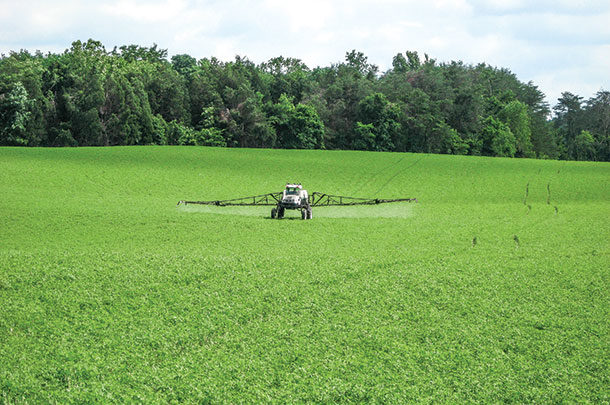Most growers with whom I work tell me they’re suffering from information overload. There is such a large volume of data available, that it’s a challenge to get through it all.
Data overload can feel overwhelming, and this situation is exacerbated by the fact that you have to determine whether or not the data is trustworthy. Does the person who conducted the research or study have a hidden agenda? Were there extenuating circumstances that might have tainted the results? Is data from another geography relevant to my operation?
“Trust, but verify” is the Ronald Reagan quote that came to mind as I was thinking about how farmers can use data to make better farming decisions. If there is a new product or technique that has gained your interest, experiment on your own farm. You can “verify” its relevance by implementing the technique on a small scale.
If you achieve positive results, then increase the size of your study. I’ve worked with growers, for example, who are interested in conducting alfalfa experiments.
Here are some examples of on-farm experiments some farmers have implemented:
-
Seeding rate: Seed part of field at your current rate, and then increase the rate to 25 to 30 pounds per acre on another part of the field.
Be sure to take field notes, weighing tonnage and noting live plants between the two areas in the field. Replicating sample areas throughout a field will add strength to the data.
-
Micronutrient application: Spray or spread a micronutrient package, specifically designed for alfalfa, on one part of field of newly established seeding. Compare tonnage and quality with another part of the field where micronutrients were not applied.
- Fungicide application: Some alfalfa and corn silage growers have experienced better plant health, more yield and better quality after applying a fungicide. Some properly applied fungicides have shown as much as a 3-ton-per-acre advantage on corn silage. Not all fungicides are the same, so work with an agronomist to apply this to part of a field and compare differences.
The most relevant, trustworthy information just may come from the experiment you conduct on your own farm. Another way to think about conducting an on-farm experiment is to envision your favorite sports team playing its biggest opponent.
Generally, there is a great advantage when a team plays on its home field. Similarly, there is a nice advantage to experimenting on your home farm. You’re getting real-world results from your land, your equipment and the microclimates that affect your farm. This type of information can provide the most meaningful and relevant information for your operation, serving as a guide to help you make stronger decisions.
Keep in mind, however, the information you glean will be based on one year with its own unique growing season. As long as I’ve been involved with farming, I have yet to see two years that are exactly alike. You’ll probably want to conduct the same experiment for more than one year to make sure results are consistent. If the results are favorable, you might even elect to increase the “sample” size in each consecutive year.
Simplification is the key to implementation
There’s only so much time to try new techniques. There are only so many hours available to read publications. That’s why, at the end of the day, I want to present data that is relevant, meaningful and repeatable.
Half the battle with using data is organizing the information, and that’s one of the benefits of subscribing to a precision farming service. However, many computer programs can help you condense and simplify farm data. These specially designed computer programs give you a custom look at each acre to help simplify your decision-making process.
Such computer programs can help reveal the soil’s strengths and weakness, so you can build a geographically customized plan that incorporates the strengths and weaknesses of each acre.
Redefining plant diets can help you achieve new yield thresholds. Research shows fertility programs influence plant performance and yield by as much as 60 percent. I once heard a plant nutritionist relate plant nutrition to our cars’ tires.
A car can run on a low tire, but it does not run efficiently. Low tire pressure, or a flat tire, restricts performance. Let’s take another look at our plans for 2016 to ensure we don’t have a proverbial flat tire in our nutrient program. Most growers already are on a great pathway to production, but they can continue to refine the process.
Not only will good plant nutrition maximize plant performance, it also creates better forage and food for animals. There are 16 essential nutrients for plant development; each one is important in various amounts.
Based on their differences, these 16 nutrients have been grouped into three categories: primary or macronutrients, secondary nutrients and micronutrients.
Whether you choose to conduct a simple experiment on your farm or you prefer to partner with a third party on a precision farming service, here’s the bottom line:
-
Test. Grid sampling shows the soil’s strength and weakness. Tissue testing plants in-season is becoming more popular as a way to determine if plants are being fed enough for them to reach their optimal yield potential.
-
Apply. While nitrogen is important, also remember there are 17 essential nutrients for crop production. A plant’s appetite changes, and it is dynamic based on current growing conditions this year. Tissue testing can help determine whether there is a true nutrient deficiency or the deficiency is due to environmental factors.
- Plan where to place it. Build an integrated crop plan that takes into consideration the soil’s strengths and weaknesses as well as your yield and soil goals. Your crop plan should include placement for seed, as well as for nutrients. Our customers are seeing results from planning their seed on a field-by-field basis. FG
PHOTO: Fertilizing. Photo courtesy of Chris Geralds.

-
Corey Catt
- Forage Product Manager
- Latham Hi-Tech Seeds
- Email Corey Catt












